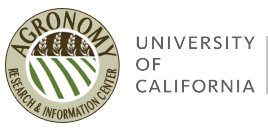- Tolomeo, V., K. Krug, and D. DeWalt, California Agricultural Statistics, 2012 Crop Year. 2012, United States Department of Agriculture, National Agricultural Statistics Service, Pacific Regional Office-California: Sacramento, California. p. 100.
- FAOSTAT. http://faostat3.fao.org. 2014 [cited 2014 September].
- Cayan, D.R., et al., Climate change scenarios for the California region. Climatic Change, 2008. 87: p. s21-s42.
- Parry, M.L., et al., Contribution of Working Group II to the Fourth Assessment Report of the Intergovernmental Panel on Climate Change. Impacts, Adaptation and Vulnerability. 2007, Cambridge University Press: Cambridge, UK. New York, NY, USA.
- Lee, J.H. and J. Six, Effect of climate change on field crop production and greenhouse gas emissions in the California’s Central Valley. , in Proceedings of the 19th World Congress of Soil Science: Soil solutions for a changing world, . 2010: Brisbane, Australia.
- Jackson, L., et al., Vulnerability and adaptation to climate change in California agriculture. 2012, University of California, Davis. p. 114.
- Cook, B.I., T.R. Ault, and J.E. Smerdon, Unpredcedented 21st century drought risk in the American Southwest and Central Plains. Science, 2015. 1(1): p. 1-7.
- USDA NASS. National Agricultural Statistics Service http://www.nass.usda.gov/. 2014.
- Pouzet, A., Agronomy, in Brassica oilseeds, D.S. Kimber and D.I. McGregor, Editors. 1994, CAB International: Wallingford, UK. . p. 65-92.
- Booth, E.J. and F.D. Gunstone, Rapeseed and rapeseed oil: agronomy, production, and trade, in Rapeseed and canola oil: Production, processing, properties and uses, F.D. Gunstone, Editor. 2004, CRC Press: Boca Raton, FL. p. 1-36.
- Duff, J., et al., eds. Growing western canola: An overview of canola production in Western Australia. 2006, Oilseeds Industry Assocation of Western Australia: Perth, Western Australia. 60.
- ERS, U. Oil Crops Yearbook. Fats and Oils: Production, Consumption and Stocks. 2014; Available from: http://usda.mannlib.cornell.edu/MannUsda/viewDocumentInfo.do?documentID=1290.
- Farré, I., M. Robertson, and S. Asseng, Reliability of canola production in different rainfall zones of Western Australia. Australian Journal of Agricultural Research, 2007. 58: p. 326-334.
- Putnam, D.H., et al., Camelina: a promising low-input oilseed., in New Crops., J. Janick and J.E. Simon, Editors. 1993, Wiley: New York. p. 314-322.
- Allen, B.L., M.F. Vigil, and J.D. Jabro, Camelina growing degree hour and base temperature requirements. Crop Ecology and Physiology, 2014. 106: p. 940-944.
- Jiang, Y., Effect of environmental and managment factors on growth and seed quality of selected genotypes of Camelina sativa L. Crantz, in Faculty of Agriculture. 2013, Dalhousie University: Halifax, Nova Scotia. p. 271.
- Boyles, M., et al., Great Plains Canola Production Handbook. 2012, Oklahoma State University. Kansas State University. University of Nebraska. Great PLains Canola Association. US Canola Association. p. 60.
- McCaffery, D., et al., Canola: Best practive management guide for south-eastern Australia. 2009, Grains Research & Development Corporation Barton, ACT. p. 92.
- Hulbert, S., et al. 2012, Washington State University Extension p. 5.
Agronomy
Oil Seeds
